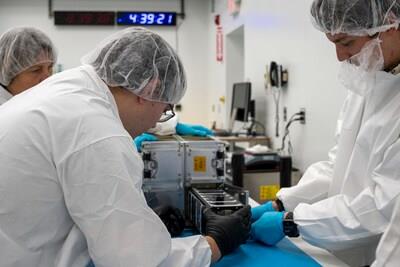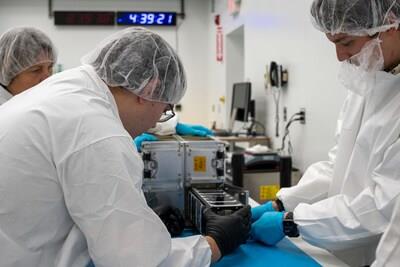
NASA Seeks Student Missions To Send To Space In 2026, Beyond
that will fly on upcoming
launches through the agency's
CSLI (CubeSat Launch Initiative).
CubeSats are a class of small spacecraft called nanosatellites. Continue Reading

Technicians with the University of Kansas prepare their KUbeSat-1 for integration at Firefly's Payload Processing Facility at Vandenberg Space Force Base, California on Thursday, April 25, 2024. Credit: NASA
The initiative
provides space access to U.S. educational institutions, certain non-profit organizations, and informal educational institutions such as museums and science centers, as well as NASA centers focused on workforce development, including the agency's Jet Propulsion Laboratory in southern California. It also encourages participation by minority serving institutions.
"Working with CubeSats is a way to get students interested in launching a career in the space industry," said Jeanie Hall, CSLI program executive at NASA Headquarters in Washington. "NASA reviews applications for CubeSat missions every year and selects projects with an educational component that also can benefit the agency in better understanding education, science, exploration, and technology."
Applicants must submit proposals
by 5 p.m. EST, Nov. 15. NASA expects to make selections
by March 14, 2025, for flight opportunities in 2026-2029, although selection does not guarantee a launch opportunity. Applicants are responsible for funding the development of the small satellites.
Selected CubeSats get assigned a launch and deployment directly from a rocket or to low Earth orbit from the International Space Station. Once accepted, NASA mission managers act as advisors to the CubeSat team, ensuring technical, safety, and regulatory requirements are satisfied before launch.
Those selected will strengthen their skills in hardware design and development and build knowledge in operating the CubeSats.
Eight CubeSat missions recently shared a ride to space
on Firefly Aerospace's Alpha rocket that launched on July 3 from Vandenberg Space Force Base in California. One mission is CatSat, built by students at the University of Arizona, which is testing a deployable antenna attached to a Mylar balloon. Another is KUbeSat-1, built by the University of Kansas, is testing a new method of measuring the cosmic rays that hit the Earth. This launch also was notable for two CSLI 'first' milestones. The KUbeSat-1 and another called MESAT-1 were the first CSLI missions from the states of Kansas and Maine respectively.
Four CubeSats
also went to the space station as cargo
in a SpaceX Dragon capsule on March 21 aboard a Falcon 9 rocket from Space Launch Complex 40 at Cape Canaveral Space Force Station in Florida as part of the agency's SpaceX 30th commercial resupply mission. Once aboard the space station, astronauts deployed the small missions into various orbits to demonstrate and mature technologies meant to improve solar power generation, detect gamma ray bursts, determine crop water usage, and measure root-zone soil and snowpack moisture levels.
CubeSats are a class of spacecraft sized in multiples of a standardized unit called a "U." A 1-Unit (1U) CubeSat is about 10 x 10 x 11 cm in size (3.9 x 3.9 x 4.5 inches). They are small enough to fit in the palm of your hand and can be stacked together to form a slightly larger, more capable spacecraft. A 3U CubeSat is three times the size of a 1U, a 6U is six times the size.
NASA has selected CubeSat missions from 45 states, Washington, and Puerto Rico, and launched about 160 CubeSats since inception.
The CubeSat Launch Initiative is managed by
NASA's Launch Services Program
based at NASA's Kennedy Space Center in Florida.
To learn more information about CSLI, visit:
SOURCE NASA

Legal Disclaimer:
MENAFN provides the
information “as is” without warranty of any kind. We do not accept
any responsibility or liability for the accuracy, content, images,
videos, licenses, completeness, legality, or reliability of the information
contained in this article. If you have any complaints or copyright
issues related to this article, kindly contact the provider above.
Most popular stories
Market Research
- Thinkmarkets Adds Synthetic Indices To Its Product Offering
- Ethereum Startup Agoralend Opens Fresh Fundraise After Oversubscribed $300,000 Round.
- KOR Closes Series B Funding To Accelerate Global Growth
- Wise Wolves Corporation Launches Unified Brand To Power The Next Era Of Cross-Border Finance
- Lombard And Story Partner To Revolutionize Creator Economy Via Bitcoin-Backed Infrastructure
- FBS AI Assistant Helps Traders Skip Market Noise And Focus On Strategy




















Comments
No comment